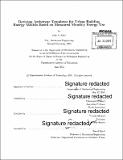| dc.contributor.advisor | Christoph Reinhart. | en_US |
| dc.contributor.author | Sokol, Julia A. (Julia Alexandrovna) | en_US |
| dc.contributor.other | Massachusetts Institute of Technology. Department of Mechanical Engineering. | en_US |
| dc.date.accessioned | 2015-12-16T16:33:57Z | |
| dc.date.available | 2015-12-16T16:33:57Z | |
| dc.date.copyright | 2015 | en_US |
| dc.date.issued | 2015 | en_US |
| dc.identifier.uri | http://hdl.handle.net/1721.1/100355 | |
| dc.description | Thesis: S.M., Massachusetts Institute of Technology, Department of Mechanical Engineering, 2015. | en_US |
| dc.description | Cataloged from PDF version of thesis. | en_US |
| dc.description | Includes bibliographical references (pages 74-78). | en_US |
| dc.description.abstract | Interest in urban energy modeling has grown among planners and policy-makers as more and more municipalities set targets for reduction of greenhouse gas emissions. Urban-scale building energy models can help evaluate the efficiency of proposed district designs, consequences of building retrofit interventions, or energy supply options. Bottom-up models based on physical descriptions and engineering calculations are the most versatile for modeling scenarios and evaluating results at high spatial and temporal resolutions. Such urban building energy models (UBEMs) are typically created by grouping buildings with similar properties into archetypes, which standardize many properties that are not uniform in reality, such as occupancy-driven parameters. Since most UBEMs are validated using aggregated, annual measured data, this standardization is usually adequate; however, for a more accurate model that considers end-use differentiation or seasonal variation, neither this standardization nor this validation method are sufficient. This work proposes a new methodology for archetype definition and customization using metered monthly energy data. Customization is done by inferring certain parameters from the energy data and estimating others probabilistically from parametric analysis. The methodology is developed and tested on a case study of 453 low-rise residential buildings in Cambridge, Massachusetts. Four model iterations are compared: single template, eight archetype templates, eight archetypes with individual building customization, and the latter with the addition of parametric analysis and generation of frequency distributions for unknown parameters. The results show an improvement in mean goodness of fit from 46% with one template and 37% with eight templates to 18% for the final iteration. The distribution of energy use intensities, as well as monthly electricity and gas profiles, approach observed values closer with each iteration. The results also demonstrate that error metrics based on aggregated annual consumption, commonly used for urban model validation, are not necessarily representative of the model's fit on a monthly basis. | en_US |
| dc.description.statementofresponsibility | by Julia A. Sokol. | en_US |
| dc.format.extent | 78 pages | en_US |
| dc.language.iso | eng | en_US |
| dc.publisher | Massachusetts Institute of Technology | en_US |
| dc.rights | M.I.T. theses are protected by copyright. They may be viewed from this source for any purpose, but reproduction or distribution in any format is prohibited without written permission. See provided URL for inquiries about permission. | en_US |
| dc.rights.uri | http://dspace.mit.edu/handle/1721.1/7582 | en_US |
| dc.subject | Mechanical Engineering. | en_US |
| dc.title | Deriving archetype templates for urban building energy models based on measured monthly energy use | en_US |
| dc.title.alternative | Deriving archetype templates for UBEMs based on measured monthly energy use | en_US |
| dc.type | Thesis | en_US |
| dc.description.degree | S.M. | en_US |
| dc.contributor.department | Massachusetts Institute of Technology. Department of Mechanical Engineering | |
| dc.identifier.oclc | 931081789 | en_US |
